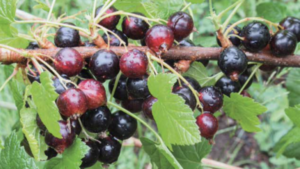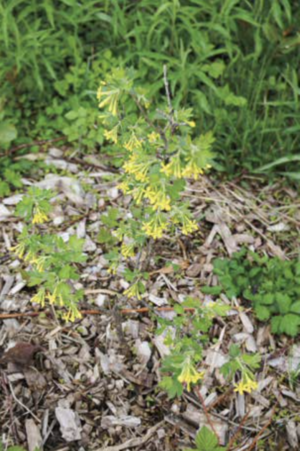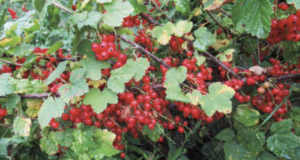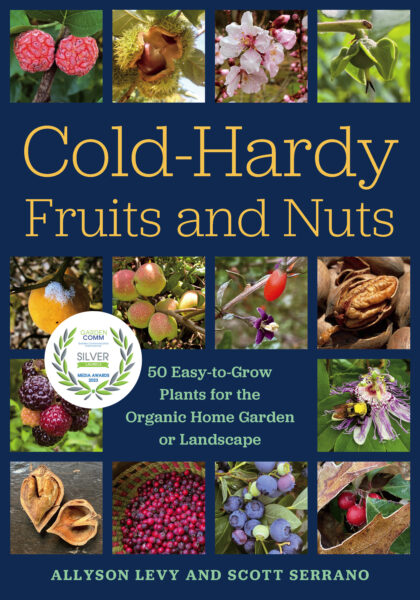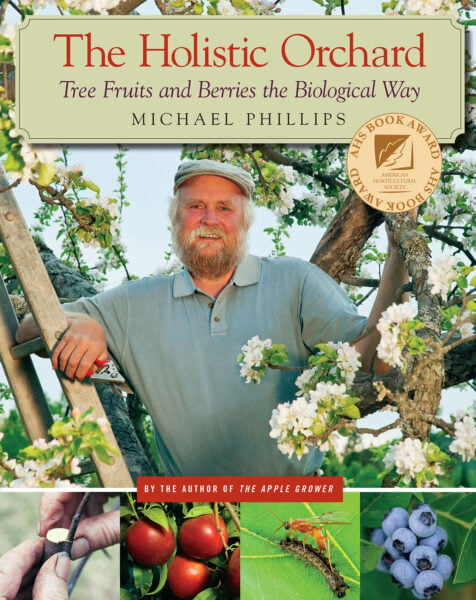The Captivating Currant: Growing & Pruning
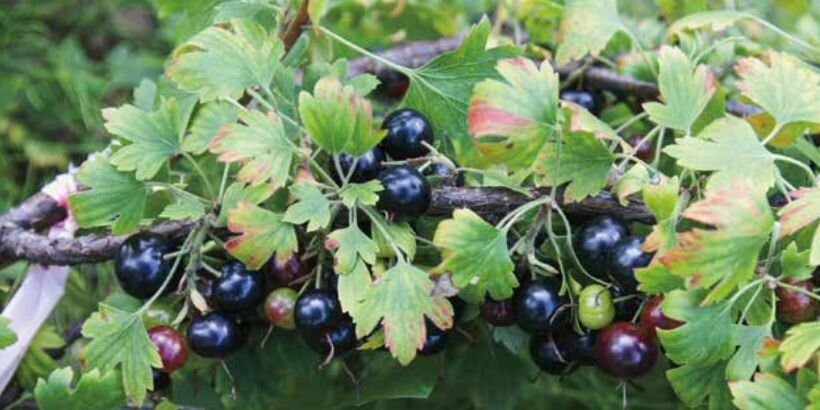
Shrubs, known as a forest garden staple, have the potential to produce beautiful flowers and delicious fruits. One of these fruits is the delightful and versatile currant. Read on to learn about the main types of currant shrubs, along with how to prune currants annually to help the shrub continue producing fruit for years to come.
The following is an excerpt from The Home-Scale Forest Garden by Dani Baker. It has been adapted for the web.
Unless otherwise noted, all photographs by Dani Baker.
Currants are fruits that range in color from white or pink to red or black. Most widely available varieties originated in Europe and were brought to North America by early settlers. One or two red currant bushes used to be a common sight near the foundations of traditional farmhouses. These berry plants were banned in the early 20th century, when it was determined that they were carriers of the invasive white pine blister rust fungus that can devastate white pine trees.
Now there are cultivars resistant to this fungus, but some municipalities still restrict these plants. Check with your local cooperative extension office to find out if they are allowed in your area.
Black Currant (Ribes nigrum)
Native Range: Central and Northern Europe and Northern Asia
Height: 4 to 6 feet (1.25–2 m)
Canopy: 4 to 6 feet
Soil Conditions: Fertile, moist soil
Sunlight: Partial shade, but tolerant of full sun USDA Hardiness Zones: 3 to 8
Black currant fruit is savory, pungent, and complex—an acquired taste for some palates. Chefs treasure this unique flavor for dessert confections and sauces for meat and fowl. I had never eaten black currants before I harvested my first fruit but developed a taste for them before long.
High in vitamins and other nutrients, the juice is a staple source of vitamin C in Europe, similar to orange juice in the United States. The fruits can be made into wine or liquor, and are a popular flavoring for vodka. Black currant leaves can be used to make a fruity herbal tea. They contain beneficial nutrients and have medicinal properties as well.
Growing & Enjoying Black Currant
When they are perfectly ripe, I enjoy eating the berries fresh and adding them to cereals and rice pudding. For processing into jams or pies, it is best to pick ripe berries mixed with underripe berries, which have the greater pectin content. Black currant jam is one of my favorites: thick and dark, with an intense flavor.
Black currants of European origin are available in a multitude of varieties—Raintree Nursery in Washington State lists over 25 cultivars in its catalog. I grow three: Ben Sarek, Consort, and Titania. The first two grow up to 4 feet tall and wide, while Titania can reach 6 feet in both dimensions. The year after I planted them, all of these bushes were loaded with ripening fruit beginning in mid-July. Harvesting of black currants is very similar to that of clove currants (“see Clove Currant,”).
Once established, these shrubs require little attention other than harvesting and annual pruning, as described in “Pruning Currants [and Gooseberries]”. They tolerate more sun than red and pink currants and do well in two full-sun locations in my garden.
Clove Currant (Ribes aureum)
Native Range: Most of US, parts of Canada and Mexico Height: 4 to 8 feet (1.25–2.5 m)
Canopy: 4 to 8 feet
Soil Conditions: Adaptable and drought-tolerant Sunlight: Full sun or partial shade
USDA Hardiness Zones: 4 to 8
Clove currant is one of my favorite fruiting shrubs. Also known as golden currant, this berry bush was traditionally used as a source of food and medicine by Native Americans. In May, its attractive yellow flowers exude a spicy aroma that hints of cloves or vanilla. Clove currant fruits are up to 1⁄2 inch (13 cm) in diameter and begin to ripen in mid-summer. In fall, the intricately shaped leaves turn dramatic shades of red. Thus, this bush has landscape appeal for at least three seasons.
I enjoy clove currant fruits straight off the bush when they are very ripe. Their flavor is not as pungent as the fruits of European black currants. They will keep refrigerated for at least two weeks. I freeze them to add to cereals, pastries, and yogurt in the winter months. And I make clove currant jams.
I am familiar with the Crandall cultivar, which grows to about 4 feet by 4 feet and has a sprawling habit, lending it to placement on a hillside. I first planted two clove currant bushes on slopes at the ends of a 50-foot-long (15 m) mound. The following spring, while chatting with my neighbor, standing at least 150 feet (45 m) from the nearest clove currant bush, I detected a pleasant aroma in the air. What was the source of this delightful odor?
Following my nose, I wandered through the garden and landed near one of the clove currant bushes in full bloom. I understood at once how the name clove currant came about. Each spring, the scent from these bushes permeates the entire garden.
Growing & Enjoying Clove Currant
You can expect to harvest fruit from this plant during the second year, or possibly the first if you are lucky. The berries are quite tart when they first turn black, but become sweeter the longer they remain on the bush. As with most berries, their quality improves the longer you wait, providing the weather is dry. When there is a lot of rain, the ripe berries absorb too much water and rapidly lose their quality and begin to decay. Since these currants ripen unevenly, they need to be “cherry-picked” by hand for fresh eating.
For processing, however, partly ripe and fully ripe berries can be picked all at once, as the less mature berries contain more pectin to help jams jell. I like to pick them all before a predicted rain to catch them when their quality is at its peak. To pick the bush clean, I use a berry- picking comb. This inexpensive tool consists of a plastic box with a handle on top and a metallic comb attached under the open end. To harvest, slide the teeth of the comb along a branch, capturing the berries as you go.
I liked my first two Crandall clove currants so much that I planted an additional dozen. Then, as I continued to develop the garden, I added another 10. I plan to incorporate another handful to replace the bush cherries (see “Bush Cherries,” page 154) that failed to thrive in my garden. These shrubs are quite adaptable. I have observed no pest or disease problems, and they require minimal pruning.
Red and Pink Currants (Ribes rubrum)
Native Range: Central and Northern Europe and northern Asia
Height: 4 to 6 feet (1.25–2 m)
Canopy: 4 to 6 feet
Soil Conditions: Moist soil rich in organic matter Sunlight: Shade-tolerant
USDA Hardiness Zones: 3 to 8
I have experience with three varieties of red currants—Jonkheer Van Tets, Red Lake, and Rovada—and one pink currant, Pink Champagne. In spring, they all sport tiny yellow blossoms massed along strings cascading down from the branches. By early July, the flowers give way to strings of sparkling red and pink berries, about 1⁄4 to 3⁄8 inch (6–10 mm) in diameter. Whether loaded with flowers or fruit, these bushes enhance any landscape.
Currants produce an abundance of fruit beginning the second year, with culinary as well as medicinal uses. Harvest is easy to do by hand, but using a berry picker comb (described in “Clove Currant,”) can be more efficient.
Growing & Enjoying Pink & Red Currant
Red currant fruits can be quite tart, but I find if they are left on the plant for a couple of weeks after turning color, they become considerably sweeter. When perfectly ripe, the gorgeous Pink Champagne fruits—which look like translucent pink pearls—are palatable for fresh eating. Traditionally, these currants are used to make a clear jelly and as an ingredient in baked goods. I like to eat them fresh mixed with yogurt or cold cereal in summer and freeze them to add to hot cereals during the colder months. The chefs I know love to use these sparkling currants as a garnish for appetizers, entrées, and desserts.
Currants belong to the gooseberry family, and all of the members of this plant family are cold-hardy and shade-tolerant. Although they benefit from moist soil rich in organic matter, currants grow well in several locations in my garden where the clay soil has been amended over time with leaves and wood chips. I have planted currants on the north side of my 50-foot-long (15 m) hügelkul- tur mounds, in the shaded part of the crescent bed, in a partially shaded hedgerow, and on a well-drained north-facing slope.
In my experience, they have no pest or disease problems. All can be propagated through cuttings, layering, and seed. For optimal production, these plants require annual pruning (see “Pruning Currants”). You may also need to net these berries to keep birds at bay.
Pruning Currants
Annual pruning improves the vigor and fruit production of most Ribes species. Another goal is to open up the center of the plants so the sun can penetrate to minimize moisture, which helps protect against fungal disease and also helps speed fruit ripening. A pair of pruning shears sterilized with isopropyl alcohol should suffice, though you may need a pair of loppers for older, thicker branches.
Red and pink currants bear the most fruit on their two- to three- year-old stems, while black currants produce the best on one- and two-year-old stems. For red and pink currants, the goal in pruning is to select and retain four to six well-spaced stems of each of the three ages: one-year-old, two-year-old, and three- year-old stems. For black currants, the goal is to select and retain four to six well-spaced one-year-old stems and four to six two-year- old stems; you may also choose to retain some three-year-old stems that bear lots of one-year-old side shoots.
When Should You Prune Currants?
It is best to prune during late winter or early spring, when the plants are still completely dormant. First, prune off the low-hanging branches. If left on the shrub, these branches will be pulled to the ground by the weight of fruit, increasing the likelihood that the fruit will rot. Next, remove any dead or damaged wood.
Step back and observe the plant to determine the age of the remaining branches. The age can be surmised from the width and color of the branch as well as how many side branches have grown from it. The lightest brown, narrowest, and straightest shoots that lack side branches are one year old. The somewhat darker, thicker branches that have some side shoots are two years old. The darkest ones with a larger number of side shoots are three years old or older.
After this assessment, (one that will become easier as you gain experience), prune out all the branches that are more than three years old. Then observe the plant again and decide on your target—will you aim to leave four branches of each age level, or six? With that goal in mind, beginning with the one-year-old stems, remove the thinnest and those that are touching another branch. Continue until the desired number remain. Do the same with the two- and then three- year-old stems.
Currant Pruning Tips & Tricks
To increase the productivity of red and pink currants, you may take the additional step of trimming each branch back by about a third of its length, cutting just above an outward-facing bud (red and pink currants) so the resulting branch will grow outward or upward respectively.
For black currants, do not trim back the branches. Do make a second assessment of the three-year-old stems. Choose two to four of them that have the most one-year-old side shoots. Retain those, and cut off the rest of the three-year-old stems at the base. As a final step in pruning all types of currants, trim out any cluttering side shoots that are blocking the light or impinging on other branches.
When you are finished, an equal number of well-spaced stems from each year should remain—8 to 15 in total depending on the vigor and growth habit of the plant. For black currants, I leave the maximum number of branches on Titania because it is a large, vigorous cultivar overall, and the minimum on the Ben Sarek variety, which tends to be smaller and less vigorous.
If this procedure sounds complicated and overwhelming, you are not alone. At first, I was reluctant to remove so much of these plants, fearing I would harm them. I also felt insecure about my ability to make the proper judgments about which stems to remove and which to leave. Nonetheless, following the advice of experts whom I respected, like Lee Reich, I held my breath and went at it. I find, as you will, that I gain in confidence each year as I improve my technique with practice and observe the plants’ positive responses. The improvement in the resulting harvest is validating.
Recommended Reads
Recent Articles
Garden strawberries are excellent for both covering the ground and for growing fruit. If you’re planning out a forest garden, or are just looking for a plant to use as ground cover, strawberries are a great option. The following is an excerpt from The Home-Scale Forest Garden by Dani Baker. It has been adapted for…
Read MoreWith the right strategies and practices, composting on a small farm is surprisingly easy and inexpensive. Just follow these steps for making compost, and your farm will be thriving in no time! The following excerpt is from The Lean Farm Guide to Growing Vegetables by Ben Hartman. It has been adapted for the web. (All photographs by Ben…
Read MoreEveryone loves a refreshing, fermented, nutritious drink…even your garden! Take your fermentation skills out of the kitchen and into the garden by brewing fermented plant juice. The following is an excerpt from The Regenerative Grower’s Guide to Garden Amendments by Nigel Palmer. It has been adapted for the web. How to Make Fermented Plant Juice Fermented…
Read MoreWant to see your crops thrive this upcoming growing season? The key is in soil fertility and health. Spend time maintaining your soil’s health to guarantee bigger and better crops come harvest time! The following is an excerpt from No-Till Intensive Vegetable Culture by Bryan O’Hara. It has been adapted for the web. What Is Soil Fertility?…
Read MoreIt’s time to take control of your seeds and become a plant breeder! Saving your seed allows you to grow and best traditional & regional varieties, and develop more of your own. The following excerpt is from Breed Your Own Vegetable Varieties by Carol Deppe. It has been adapted for the web. Becoming A Plant…
Read More

